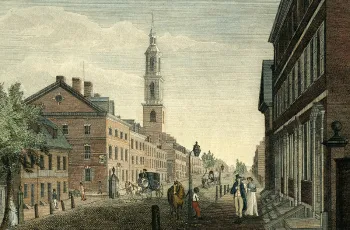History of the Church

Presbyterianism in a wide sense is the system of church government by representative assemblies called presbyteries, in opposition to government by bishops (episcopal system), or by congregations (congregationalism). In its strict sense, Presbyterianism is the name given to one of the groups of ecclesiastical bodies that represent the features of Protestantism emphasized by French lawyer John Calvin (1509-1564), whose writings crystallized much of the Reformed thinking that came before him. The most important standards of orthodox Presbyterianism are the Westminster Confession of Faith and Catechisms of 1647. The chief distinctive features set forth in the Westminster declarations of belief are Presbyterian church government, Calvinistic theology, and the absence of prescribed forms of worship. Presbyterians trace their history to the 16th century and the Protestant Reformation.
Presbyterians were among the earliest Reformed immigrants to America. They settled up and down the East Coast, and began to push westward into the American wilderness, founding congregations as early as the 1630s. In 1706, seven Presbyterian ministers formed the first Presbyterian presbytery in the New World. The clergy assumed the freedom to organize and the right to worship, preach, teach, and administer the sacraments. Growing population and immigration prompted the presbytery to organize a synod in 1717, with four constituent presbyteries.
The church began to develop its own indigenous leadership and educational, mission, and charitable institutions, as well as to experience its first internal conflicts.
Presbyterians were only one of the reformed denominations that dominated American colonial life at the time of the Revolutionary War. Presbyterians participated in the writing of state and national constitutions. Reformed views of God's sovereignty and of human sinfulness moved the new nation toward checks and balances and separation of powers. Independence forced adjustment in church as well as government structures. In 1788, the synod met in Philadelphia to form the General Assembly of the Presbyterian Church in the United States of America (PCUSA). It adopted a constitution that included a form of government, a directory of worship, and subscription to the Westminster Confession and the Larger and Shorter Catechisms. In 1789, the General Assembly held its first meeting in Philadelphia. In the early years of the 1800s, the church carried on revivals and organized congregations, presbyteries, and synods wherever they went, emphasizing the connectional nature of the church. Presbyterians helped as well to shape voluntary societies to encourage educational, missionary, evangelical, and reforming work. As the church began to realize that these functions were corporate in nature and as the century proceeded, it formed its own boards and agencies to address these needs at home and abroad. Mission to Native Americans, African Americans, and populations all over the world became a hallmark of the church.
The nineteenth century was also characterized by disagreement and division over theology, governance, and reform-particularly slavery. The century saw the formation of additional denominations, such as the Cumberland Presbyterian Church and the United Presbyterian Church of North America. When the country could not reconcile the issue of slavery and the federal union, the southern Presbyterians split from the PCUSA, forming the PCCSA in 1861, which became the Presbyterian Church in the United States. The themes of the late nineteenth and all of the twentieth century are many. To be Presbyterian is to be ecumenical, and the church participated in the many organizations such as the Alliance of the Reformed Churches throughout the World holding the Presbyterian System (which became the World Alliance of Reformed Churches in 1970 and then in 2010 joined with the Reformed Ecumenical Council to form the World Communion of Reformed Churches), the Federal Council of Churches and its successor, the National Council of Churches of Christ in the USA, and the Consultation on Church Union succeeded by Churches Uniting in Christ.
This era also saw an amazing growth and decline of foreign mission work and controversy and division over worship and the confessions. Women's issues, civil rights and other social justice issues, and service to diverse congregations, including Korean Americans, were also significant in the life of the church. Reorganization and loss of membership characterized this period as well.
Presbyterian denominations in the United States have split and parts have reunited several times. Currently the largest group is the Presbyterian Church (U.S.A.), which has its national offices in Louisville, KY. It was formed in 1983 as a result of reunion between the Presbyterian Church in the U.S. (PCUS), the "southern stream," and the United Presbyterian Church in the U.S.A. (UPCUSA), the "northern stream." The UPCUSA was formed by the merger (1958) of the Presbyterian Church in the United States of America, descending from the Philadelphia presbytery of 1706, and the United Presbyterian Church of North America, which had been constituted (1858) by a union of two older churches. Other Presbyterian churches in North America include: the Presbyterian Church in America, the Orthodox Presbyterian Church, the Evangelical Presbyterian Church, the Cumberland Presbyterian Church, the Cumberland Presbyterian Church in America, the Associate Reformed Presbyterian Church, and the Presbyterian Church of Canada.
As of 2021, the Presbyterian Church (U.S.A.) had just over 1.1 million members and 8,800 congregations.
